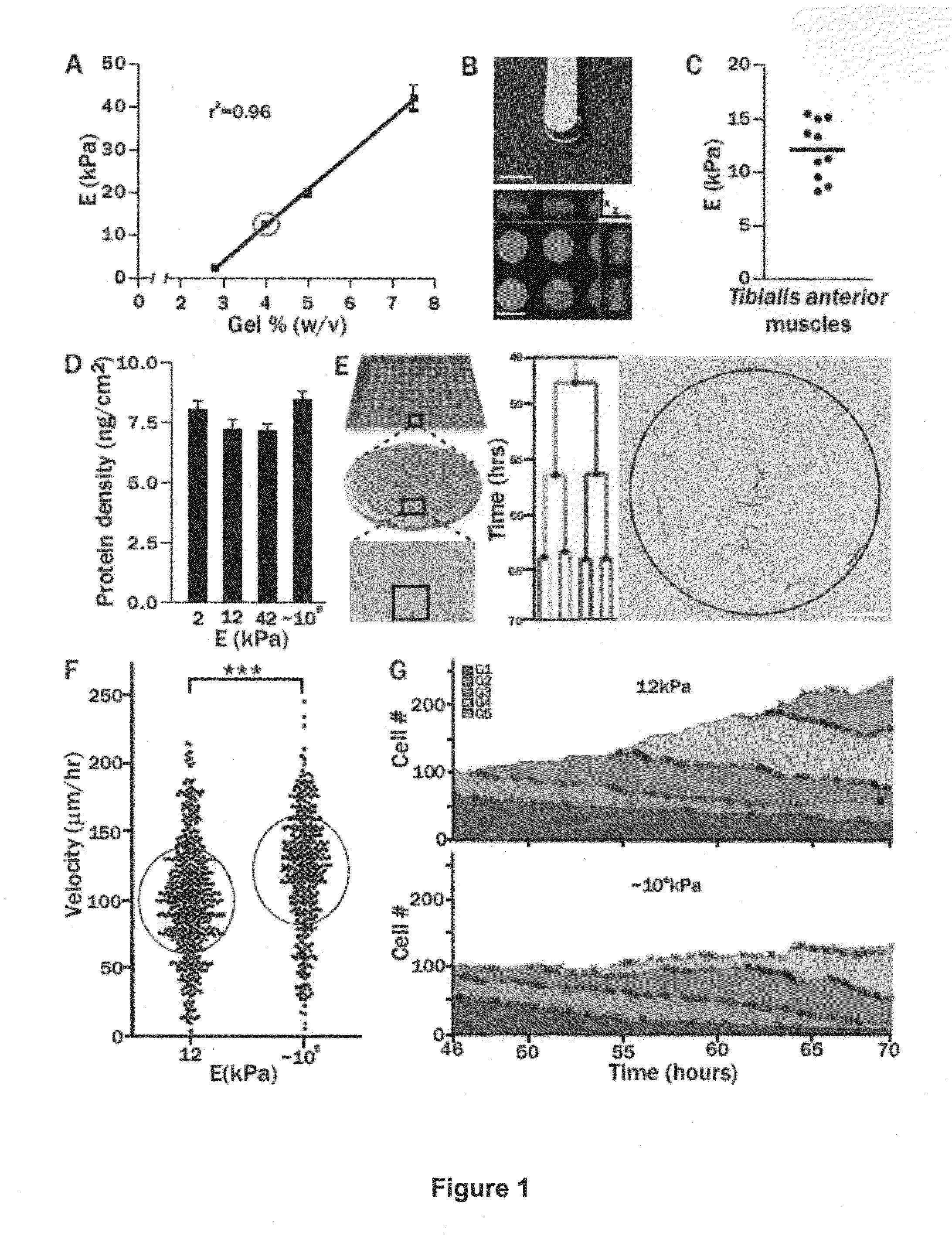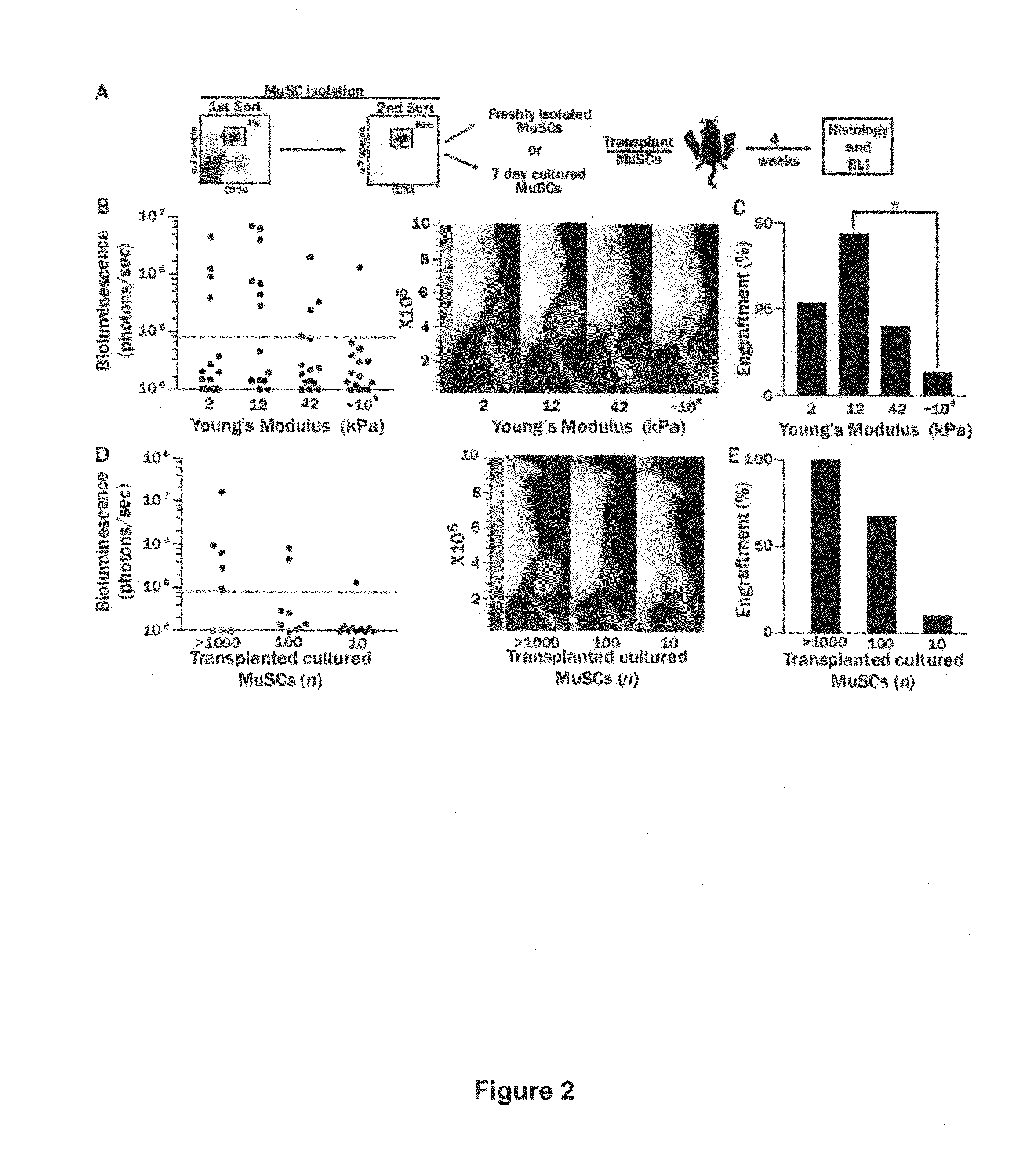Elastic substrates and methods of use in cell manipulation and culture
a technology of elastic substrates and cell manipulation, applied in the field of elastic substrates and methods of use in cell manipulation and culture, can solve the problems of difficult identification, isolation, purification, and rapid loss of muscle stem cell properties, and achieve the effect of increasing the number of stem cells and increasing the number of cells
- Summary
- Abstract
- Description
- Claims
- Application Information
AI Technical Summary
Benefits of technology
Problems solved by technology
Method used
Image
Examples
example 1
[0225]The muscle microenvironment (niche) enables freshly isolated muscle stem cells (MuSCs) to contribute extensively to skeletal muscle regeneration when transplanted in mice. These include satellite cells and other cells that are capable of contributing to muscle (D. D. Cornelison et al. (2001) Dev Biol 239, 79; S. Fukada et al. (2004) Exp Cell Res 296, 245; D. Montarras et al. (2005) Science 309, 2064; S. Kuang et al. (2007) Cell 129, 999; M. Cerletti et al. (2008) Cell 134, 37; C. A. Collins et al. (2005) Cell 122, 289; A. Sacco et al. (2008) Nature 456, 502; R. I. Sherwood et al. (2004) Cell 119, 543; and Galvez et al. (2006) J Cell Biol. 174(2):231-43). In contrast, muscle stem cells grown on standard tissue culture plastic lose ‘sternness’ yielding progenitors with greatly diminished regenerative potential (D. Montarras et al. (2005) Science 309, 2064; A. Sacco et al. (2008) Nature 456, 502; Z. Qu-Petersen et al. (2002) J Cell Biol 157, 851) and therapeutic potency (E. Gusso...
example 2
Method of Gel Fabrication
[0268]Sulfhydryl (SH) groups on 4-armed PEG (PEG-SH) are reacted with vinyl sulfone (VS) groups on 8-arm PEG (Polyethylene Glycol Vinyl Sulfone, or PEG-VS). The resulting preparation results in the formation of non-swelling PEG (NS-PEG) hydrogels. The method converts the end groups of polyethylene glycol (PEG) to vinyl sulfone. A large excess of divinyl sulfone is used to react with the end groups, yielding an intact vinyl sulfone moiety at the end of each PEG chain. The reaction mechanism is shown in scheme. 1.
[0269]A strong base, in this case sodium hydride, is used to deprotonate the diol group, leaving O— as a strong nucleophile to react across the double bond of the divinyl sulfone.
Weight of PEG5gMW of PEG10000DaNumber of arms8Concentration of DVS0.67MMolar Excess Sodium Hydride15Quantities of reagentsPEG5gDivinyl Sulfone9.5gSodium Hydride dispersion2.4gTotal Reaction Volume120mLVolume DCM in flask90mLVolume DCM in funnel20mL
[0270]The rate of reaction i...
example 3
ART Techniques
[0280]ART techniques to which the invention applies include but are not limited to: Egg collection, in which oocytes are gathered from the ovaries, typically through a needle inserted through the vaginal wall. The invention provides methods and systems to receive the oocytes in a container with an elastic substrate.
[0281]Sperm collection and processing, in which sperm are donated by a male and either frozen for future use or used fresh. The invention provides methods and systems to receive sperm in a container with one or more elastic substrates during collection, for example sperm collection containers containing elastic substrates.
[0282]Sperm activation, in which sperm are cultured for a few hours in an environment which activates them, meaning it causes them to become more motile. The invention provides methods and systems to culture sperm in contact with one or more elastic substrates during activation, for example Petri dishes containing elastic substrates.
[0283]B...
PUM
| Property | Measurement | Unit |
|---|---|---|
| Fraction | aaaaa | aaaaa |
| Time | aaaaa | aaaaa |
| Pressure | aaaaa | aaaaa |
Abstract
Description
Claims
Application Information
 Login to View More
Login to View More - R&D
- Intellectual Property
- Life Sciences
- Materials
- Tech Scout
- Unparalleled Data Quality
- Higher Quality Content
- 60% Fewer Hallucinations
Browse by: Latest US Patents, China's latest patents, Technical Efficacy Thesaurus, Application Domain, Technology Topic, Popular Technical Reports.
© 2025 PatSnap. All rights reserved.Legal|Privacy policy|Modern Slavery Act Transparency Statement|Sitemap|About US| Contact US: help@patsnap.com



